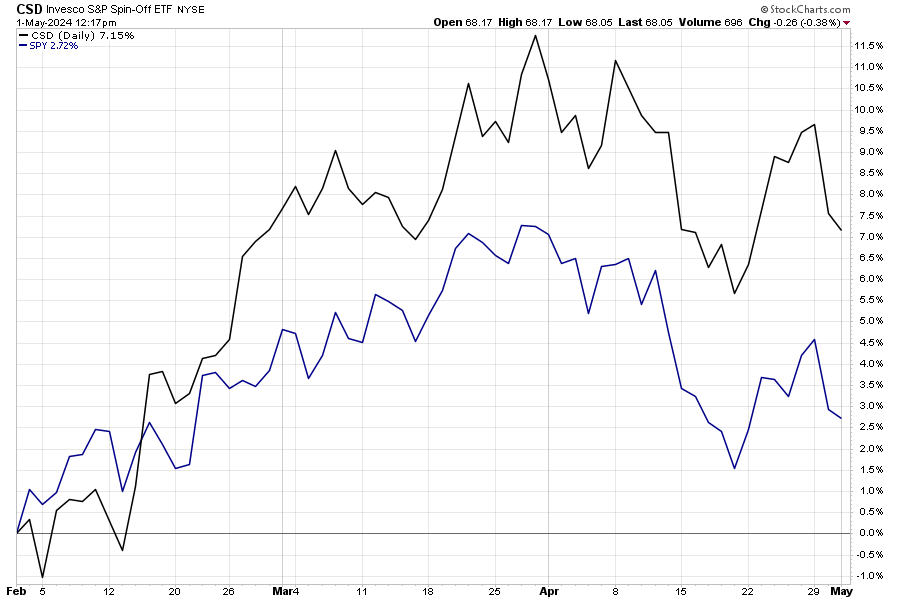Street Calls of the Week
-
The spin-off ETF has outperformed the S&P 500® lately as major companies seek leaner operations
-
Pressure from activist investors may also be stirring up spin-off volume
-
As stock splits sour and IPO activity remains light, executives might continue to seek to add value through crafting spin-offs.
Stocks sank in April as inflation fears continued to permeate investors’ psyche. Spice in a few weak economic reports on the growth side of the ledger, and the dirty s-word is being tossed around: stagflation. Now, that may be a bit dramatic, and Chair Powell dismissed the notion last week, but there’s no doubt that the Federal Reserve has its work cut out for itself should recalcitrant inflation and ebbing GDP numbers persist over the balance of the year.
Last month featured steep losses among almost all 11 S&P 500 sectors. Only Utilities was up while Energy was slightly in the red. But one factor flew under the radar for its relative strength - spin-offs. Shares of companies that recently separated from a larger firm managed to hang in there. The Invesco S&P Spin-Off ETF (NYSE:CSD) was up more than 7% for the three months ended May 1st, outperforming the S&P 500 by nearly five percentage points.
S&P Spin-Off ETF In Favor Since Early 2024

Source: Stockcharts.com
Why go for a Spin?
These new standalone companies, it’s thought, allow separate management teams to take charge and lead with a focused approach. Spin-offs may also help the parent firm get down to business on core operations, improve efficiencies, and react quicker to changing macro and industry-specific conditions.
Spin-offs are potentially attractive from a strategic point of view because they can unlock value without being detrimental to existing shareholders of a parent company. It’s a rather efficient way for executives to shed nonessential or even underperforming businesses through the creation of a smaller, more agile fresh entity. Spin-offs might also be looked at to thwart would-be outside firms from coming in and breaking up a stand-alone conglomerate.
IPOs? Nah. Stock Splits? Where Have Those Been?
For investors, you will be hard-pressed to find much in the way of new companies to dig into. The IPO market remains generally cool, though a few decent-sized offerings have made headlines, such as Viking (VIK) last week. Viking, the popular senior-focused cruise line, is interesting as it highlights the apparent preference to list in the U.S., not abroad.
Big picture, it seems investment banks will have to keep biding their time before they can once again collect high-margin fees by bringing young public companies to market. For now, they’ll have to be satisfied with robust corporate debt issuance activity and wealth management profits.
It’s also quiet on the stock-split front. Recall it was two years ago now when high-growth companies were eager to reduce their share prices to attract buyers. Our data show that while there have been splits here and there, such as Walmart’s (WMT) 3-for-1 split back in February, there is certainly no imminent sign of a sharp pickup there. Instead, it may be that the rise of activist investors and dry powder in the private equity space could be fuel for spin-offs.
Reviewing Recent Spins
Putting this corporate action in the spotlight in the last handful of months amid a quiet IPO landscape and fewer stock splits are a handful of big-name spins.
1. General Electric – GE Healthcare (GEHC) and GE Vernova (GEV)
Facing pressure from Nelson Peltz at Trian Partners, GE (NYSE:GE) used spinoffs to determine its own destiny. As part of a years-long strategy, GE Healthcare and GE Vernova are now publicly traded stocks. The former recently stumbled following a troubling earnings report, but GE Vernova has performed well since its debut in late March. GE, the parent, continues to soar – shares are about double where they were this time last year, bringing GE back to glory and atop the list of S&P 500 Industrials sector equities as of April 30, 2024.
2. 3M (MMM) – Solventum (SOLV)
3M has been at the center of a litigation storm as its executives (and lawyers) grapple with a slew of settlements over military earplugs and “forever chemicals.” The Minnesota-based blue chip said it would cut its dividend following the spin-off of its healthcare unit amid legal issues. Did Solventum, a member of the Health Care Supplies industry, fix anything? Perhaps for the parent. 3M (NYSE:MMM) shares jumped to 52-week highs after Q1 results in late April, but SOLV plunged after it began trading at the tail end of the first quarter.
3. Kellanova (K) – WK Kellogg
While not in the Spin-Off ETF, KLG (NYSE:K) has been a big winner since hitting the tape back in September 2023. Shares plunged 40% initially, but are now up more than 40% over its short life. Just a $2 billion market cap Packaged Foods and Meats firm in the Consumer Staples sector, the cereal maker has bucked bearish trends that have hit other sugary product makers in the last few quarters. Kellanova, the parent, posted solid Q1 numbers last week, and shares jumped to fresh year-to-date highs.
4. Danaher - Veralto (VLTO)
And then there’s Danaher’s (NYSE:DHR) former baby, Veralto. VLTO operates through two segments: Water Quality and Product Quality & Innovation. The stock has done more than tread water, though, as it, like KLG, endured a rough beginning, but has cleaned up for shareholders. VLTO rallied from under $70 in Q4 last year to above $90 today. In April, the firm reported a solid double-beat on earnings and revenue, and now trades at a premium valuation.
The Bottom Line
The latest set of Wall Street spin-offs weaves a compelling story as CEOs consider both capital and operational plans for the rest of the year. Slimming down may indeed be en vogue while volatility kicks up in global equity markets. With significant alpha generated by some of the fresh firms mentioned, this corporate event trend shows few signs of ending.
